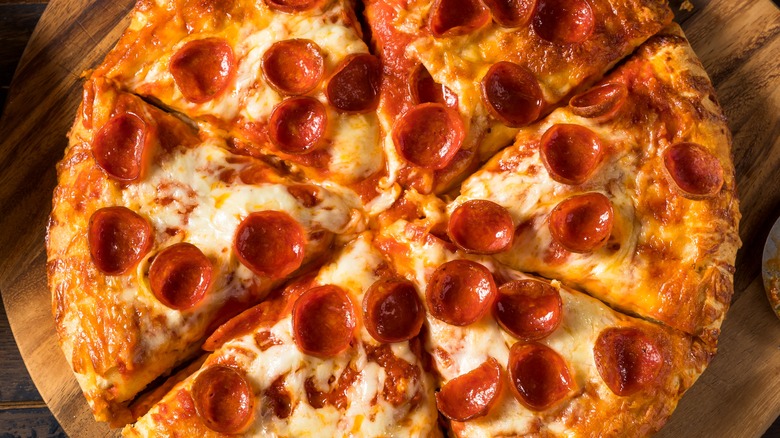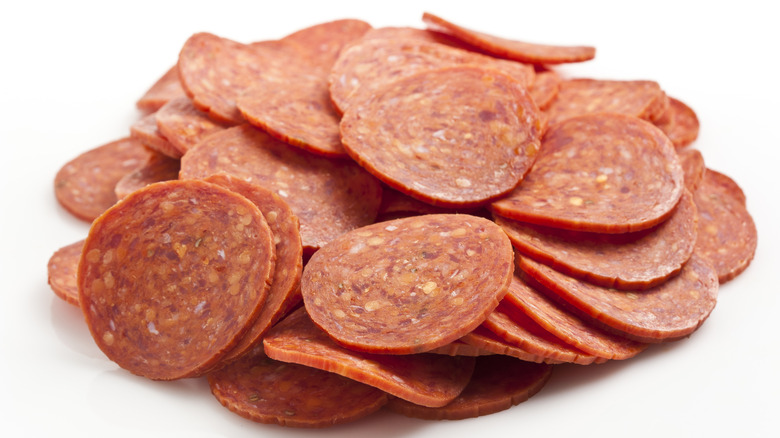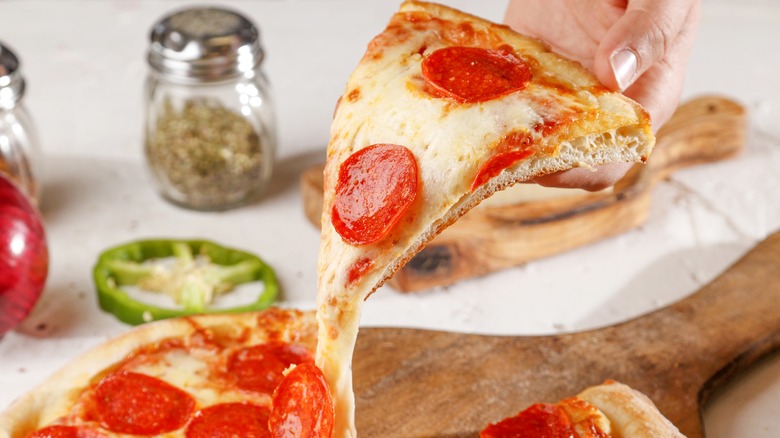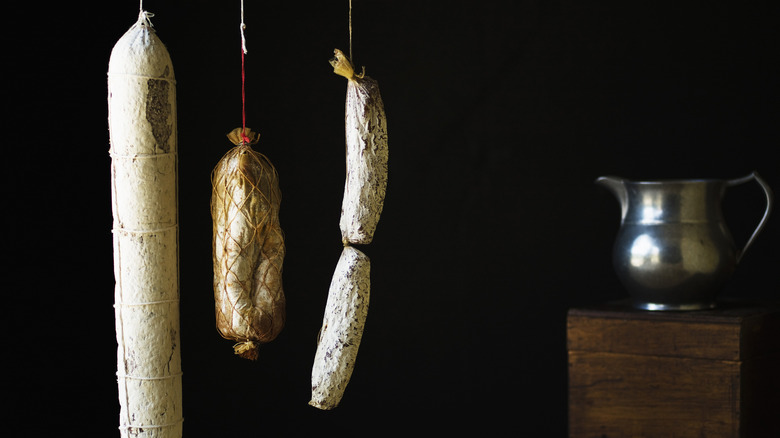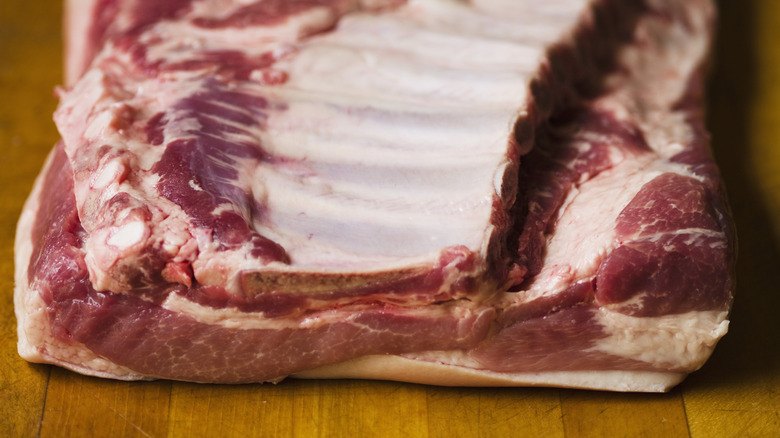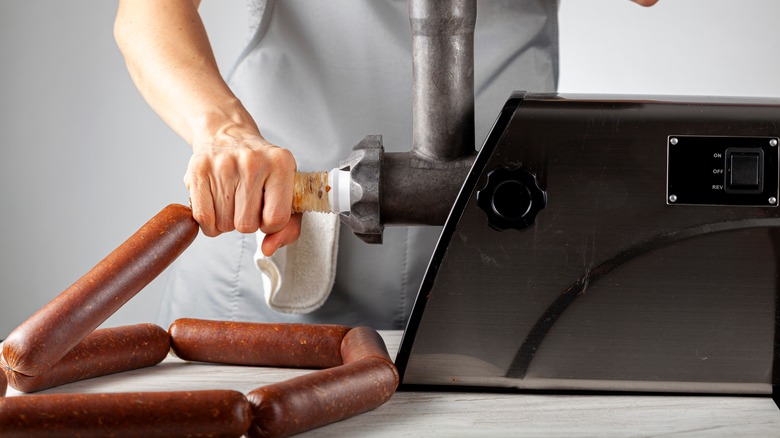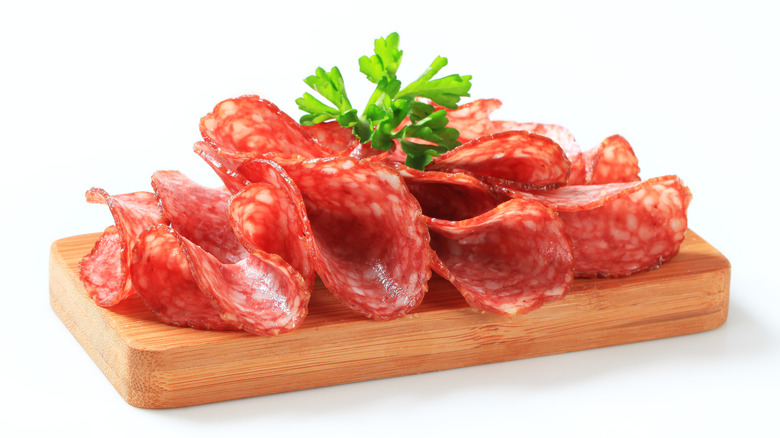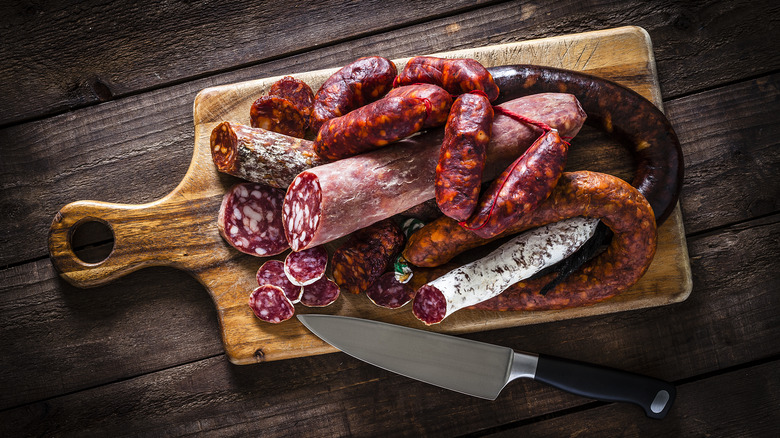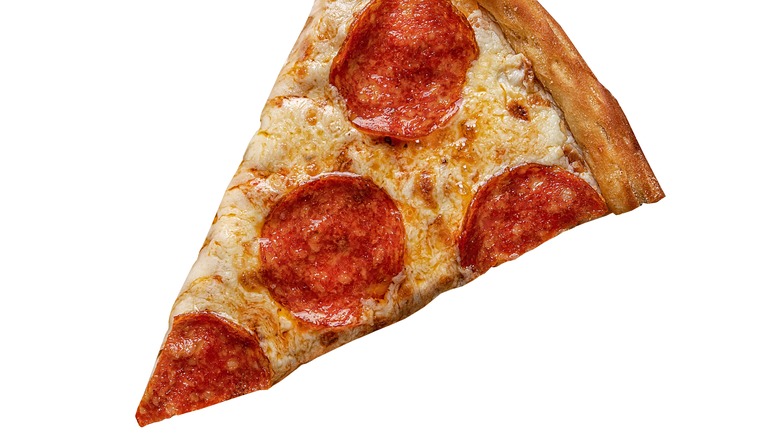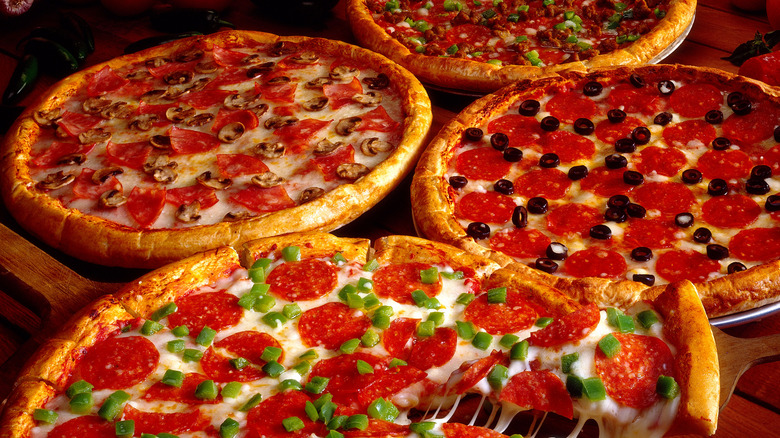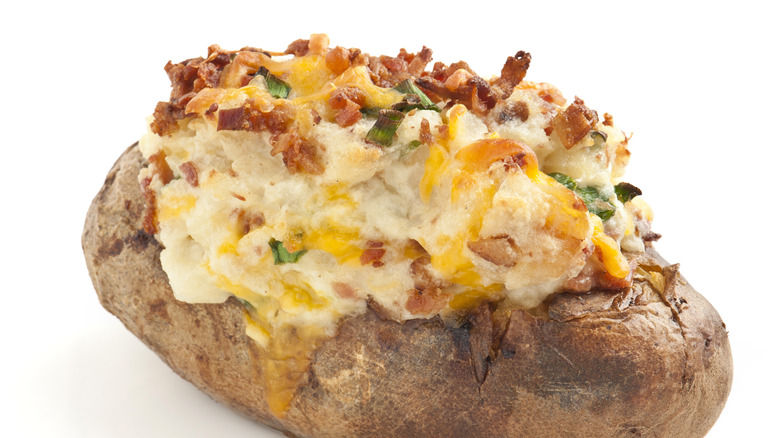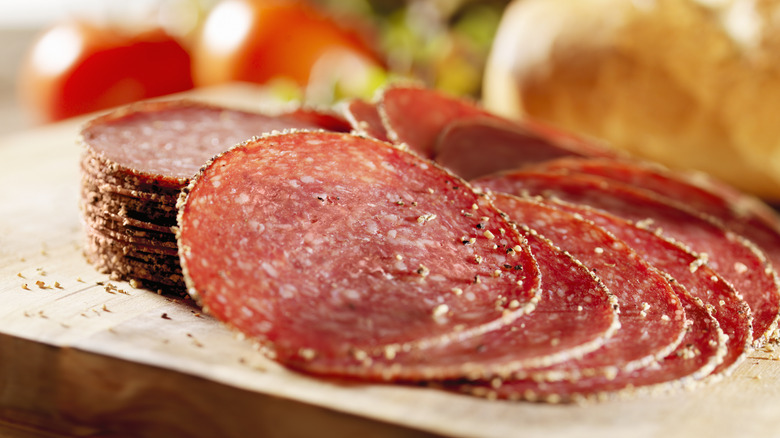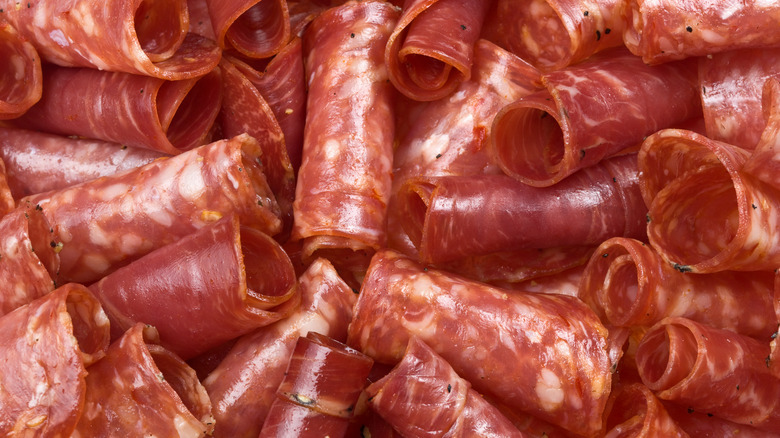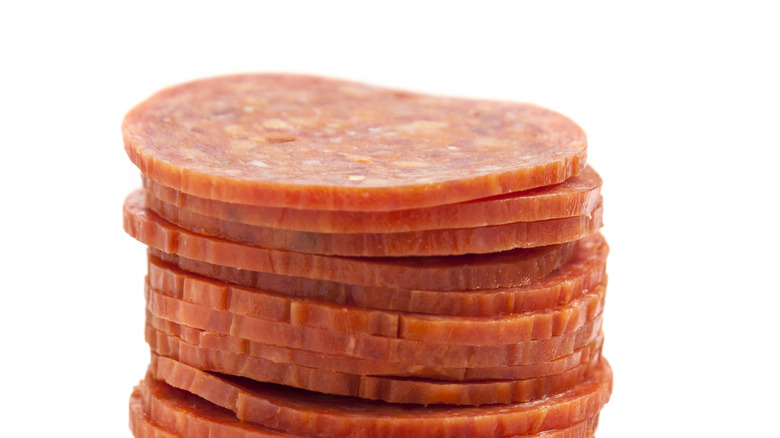Everything You Need To Know About Pepperoni, Pizza's BFF
No Little League game would be complete without cardboard boxes full of piping hot pepperoni pizza. The same can be said for Field Day, football night, or a relaxed Friday at home, where it's the perfect low-fuss dinner (and even tastes good cold). While the dedication to this spicy cured meat topping is deep, though, how much do you really know about pepperoni?
Well, you're in luck, because here's your complete primer on all things pepperoni: what it is, how it's made, how to store it, where to buy it, how to cook with it, how to jazz up your frozen pizza with it, possible issues associated with this heartburn-y meat, and more. And it's not just pizza: you'll also learn what else you can do with pepperoni once you routinely stock it in your home kitchen. The truth is, pepperoni might be pizza's BFF, but it's a much more interesting and versatile food than many people realize.
Just what exactly is pepperoni?
Folks so often associate pepperoni with pizza that they forget it's actually a type of dried sausage, invented by Italian Americans in 20th century New York City. However, it didn't replace traditional sausage as a topping until the '50s or so, slowly becoming popular over the next several decades. Today, its grease-laden presence on pizzas from every purveyor is as American as apple pie ... but what is it?
While quite similar to its cured-meat cousins salami and chorizo, and usually eaten thinly sliced just like them, it has its own distinct ingredients, uses, and flair. Pepperoni is a sausage made of pork and beef from cuts that feature a 70-to-30 lean-to-fat ratio. Its makers then add spices such as garlic, paprika, cayenne, black pepper, salt, and sugar, though fennel, anise, mustard, or allspice may also make their appearance. These variations account for the slight differences in taste you get from different pizzerias, though pepperoni is always recognizable to those who love it.
Once mixed, pepperoni gets a shot of Lactobacillus, a bacteria common in cheese and pickled veggies, and the sausage casing treatment. It is then fermented, smoked, and dried, a process that takes several weeks. Et voilà! It's ready for any variety of pie from thin-crust to Chicago-style pizza, though it can also feature on mezzo platters, charcuterie boards, and the cult hit pepperoni rolls.
It's America's favorite pizza topping, with mixed reviews overseas
In a YouGov poll of U.S. citizens in which people assigned a score to pizza toppings ranging from "love it" to "hate it," pepperoni weighs in just behind extra cheese. While 51% ranked max cheesiness as a love of theirs, 50% of people claimed to adore the spicy sausage as well, making it the most popular topping overall. (That's if you assume that cheese is a given. And you should, because cheese-less pizza is nuts.) Likely you won't be surprised to learn that anchovy was the most-panned topping.
Despite the true-blue American love for pepperoni, its popularity varies overseas. It's a hit in the U.K., which often follows U.S. tastes. However, it's harder to get on Europe's mainland, where sausage is usually preferred. And while pizza abounds in Southeast Asia, you'll usually find Margherita or veggie pizza ... though hot dogs are not an uncommon addition in this traveler's experience. In Italy, you can avoid disappointment by studying the menu carefully. There, peperoni, spelled with just two p's, signals bell peppers, so make sure to ask for "pizza diavolo" instead.
Pepperoni is a cinch to store at home
Pepperoni is a perfect meat to put on your survivalist food list. For one thing, it has a high fat content. Fat is an excellent preservative because it creates a barrier against oxygen, which harmful bacteria need in order to consume (e.g. spoil) your pepperoni. Add to that its incredibly high salt content, and pepperoni can be stored for 6 weeks at room temperature and literally indefinitely in the fridge.
Still, there are a few things to know about keeping pepperoni good at home. For one thing, those lengths of time apply to unopened salami. Once you slice it or open the package, you must put it in the fridge and eat it within 3 weeks, as these break the cured antibacterial seal. Make sure you put it in an airtight container or plastic bag and squeeze out the air as much as you can to extend its shelf life. If you see mold, toss it. There are better ways to get penicillin, should you need it.
What does pepperoni taste like?
Pepperoni's flavor comes straight from its production process. It has a delicious spiciness, which isn't the same as being hot, although it can be. You'll also taste rich pork and beef, not to mention experience that fatty mouthfeel that comes only with good dried sausage. The fat comes largely from the pork cuts used: shoulder and belly for the most part. Common spices like paprika and garlic come forward on the palate.
The type of meat from which the sausage is made has a lot to do with its flavor, so newer pepperonis made with turkey may have a subtler, slightly gamier, yet less rich taste to them. Anyone who has tasted the difference between turkey and beef jerky can imagine the change in flavor. Pepperoni is also less fatty when you use turkey, since the latter lacks the high fat content of pork belly and shoulder.
Another difference in the dining experience comes from what type of casing the sausage uses. This won't necessarily change the flavor of the sausage, but it may affect the bite and chew. Collagen casings are made from modified animal hide and are tougher than natural casings made from intestines. (You may have noticed this as a weirdly thick peeling layer on the outside of a sausage.) Traditional pepperoni doesn't use collagen, and you can determine the difference by reading the package before you buy it.
How to make pepperoni
While pepperoni seems like one of those ingredients you shouldn't even attempt at home, it's easier than you might think. Whether you do the whole enchilada and order casings like a chef or simply take the easy route, you might be surprised at what a dedicated foodie can produce right at home by simply choosing your favorite online recipe, of which there are numerous options.
In general, you mix up your pork and beef at about a 2-to-1 ratio, respectively, and then add seasoning. You can buy this online or mix it up yourself by conducting a web search on "pepperoni seasoning" and choosing your favorite heat level, spices, and saltiness. You will also add curing salt, water, and other ingredients depending on your recipe. Stuff your traditional or collagen casings using a sausage stuffer (a widely available handheld device that looks like a giant hypodermic needle) or form the pepperoni seasoning into log shapes and wrap them with plastic. Then let the sausages ferment in the fridge for 24 hours.
If desired, you can go all the way and smoke your sausages. For meat enthusiasts who routinely do this with fish or game, it isn't tricky at all. Just put them in your smoker according to the recipe instructions. For a lower road, add a few drops of liquid smoke to the recipe while mixing, then stick your sausages in a 325 F oven until the inner temperature reaches 140 F.
Exploring different pepperoni varieties
There exist many varieties of pepperoni. In addition to home recipes, you can find almost every variation under the sun when you shop for it: turkey versus the classic pork and beef, mild or extra spicy, and with or without chemical additives (sodium nitrates and nitrites), for instance. Many pepperoni sausages are cured (e.g. fermented and smoked) while some are uncured like the typical Italian sausages you'd eat for dinner. There are many good options, and some to steer clear of.
Ideally, you want to skip anything that has nitrates or nitrites in it. These are food stabilizers, meant to make pepperoni last longer. While the compounds themselves aren't harmful, they can interact with other compounds in the body to form carcinogens that over time may increase your risk of cancer, according to a study in the journal Antioxidants. Where possible, buy pepperoni that is free of nitrates and nitrites.
The good news is that people have been curing meat for tens of thousands of years using nothing more than salt, spices, and friendly bacteria. These recipes are still widely available. Among these options, you'll find many different types of meat, spices, heat levels, widths, and sliced or unsliced versions. All pepperoni is cured, which performs the same microbe-killing benefits as cooking, so you can eat it right out of the package if you like.
Where to buy pepperoni
Pepperoni is widely available in grocery stores, import stores such as Cost Plus World Market, and online. You can also find it at Italian delis, butchers, and specialty shops. If you're looking for pre-sliced pepperoni, hit up a grocery store, butcher shop, or deli. There, you can choose the type you want at the meat counter and have them slice it to your desired thickness. You don't want it to burn in the oven, so avoid wafer-thin slices and go for something with a bit of toothiness. Recommendations vary, but between 3 and 6 millimeters or ⅛ inches should be safe. If you buy your pepperoni pre-sliced in a package, make sure to check the expiration date.
If you're in search of a nice cured pepperoni to give as a gift, add to a meat board, or put on a haute cuisine pizza in a wood-fired oven, your best bet is an import or artisanal store that can get you a true Italian version. Be prepared to pay more. For the best of the best overall, check out this list of the best pepperoni brands.
What's the deal with vegan pepperoni?
"Vegan pepperoni" might sound like an oxymoron, but in fact, much of pepperoni's flavor comes from the spices used to make it. Sure, if you're a carnivore, you probably won't be convinced by fake pepperoni. However, if you're a vegetarian/vegan or you simply try to limit your meat, you could be surprised by how convincing vegan pepperoni is.
So what's it made of? That will vary with the brand. Typically, the colloquially named "fake meats" are composed of combinations of soybeans, other legumes, mushrooms, wheat, and fermented soy products such as tofu or tempeh. To this, vegan pepperoni makers add the standard pepperoni spices as well as liquid smoke to give it that realistic smokehouse finish. More and more frozen pizza lines offer vegan pepperoni pizza.
If you're a consummate foodie who loves trying new recipes, you can even make it yourself by subbing out the meat for plant-based protein, adding the same pepperoni spices, salt, and a few drops of liquid smoke, and cooking it. Some recipes have you roll out the mixture and make cookie-cutter circles before baking, while others create a true sausage log you can slice afterward. Choose your own adventure!
Putting pepperoni on frozen pizza
You'd think adding a little extra flair to your frozen pizza would be easy enough, but there are some dos and don'ts. Do take the time to rearrange your frozen toppings, because they're never distributed evenly and it's frankly just disappointing. Don't add pepperoni or other toppings at the beginning of cooking, for the most part. Cured meat is already, well, cured, so it's safe to eat as is (yes, even disgusting and cold right out of the package). Adding at the beginning of a 15-minute cooking time will just burn it especially easily due to all that fat.
The best way to add pepperoni to a frozen pizza is to precook it a little by throwing it into the microwave for a few seconds to get a crisp on it. You can then pop it on the pizza when you have a few minutes left of your cooking time. Or you can fully crisp it, then add it to your frozen pizza after it's completely done cooking, along with other toppings such as Parmesan cheese, baby arugula, marinated artichoke hearts, and olives.
Substitutes for pepperoni on pizza
All right, so you don't have enough (or any) pepperoni for tonight's cheesy plans. What's a cook to do? Luckily, there are quite a few other cured sausages that will taste delicious on your pizza as well and won't change the overall effect that much.
First, note that Italians call pepperoni "salame piccante," which means "spicy salami." That should clue you in to the similarities between pepperoni and what you might call "regular" salami, which are many. They use similar meat, both have a high fat content, and are cured in similar ways. The only difference is the spiciness factor, making salami a nice substitute for pepperoni if you're out. Try to buy the smaller salami logs so that the pizza has the same speckled-across-the-pizza effect rather than being covered with giant pieces. If you want to bring the spice kick back in, you can use red pepper flakes or jalapeños. Other hard sausages you might consider include chorizo, soppressata, and any type of hard salami (of which there are many). As discussed, vegan pepperoni isn't too bad, either.
If you're really stuck, you can ditch sausage altogether and opt for short ribs or another kind of meat. Anything pork or beef will likely have a pepperoni-esque feel since they're both main ingredients in the sausage. That makes ham, bacon, ground beef crumbles, and pulled pork good options.
Pepperoni for lunch and dinner meals
Pepperoni might be pizza's BFF, but it's good in so many other things as well. Think charcuterie boards, wine pairings, calzones, and perfectly melted grilled cheese sandwiches. Or pepperoni-wrapped olives stuffed with fresh-peeled garlic. It's not that expensive, either, clocking in significantly lower than salami at most grocery stores and online outlets. This makes it a great choice for price-shopping parents or retirees on an income, especially given how versatile it is.
Stock pepperoni in your fridge to throw into lunchtime sandwiches for those who want an extra-spicy kick, since it's good as a cold cured meat as well. You can fry it up in a pan or crisp it in the microwave, then crumble it on top of baked potatoes. Or you can throw it into your quesadillas for an extra-special kick on Mexican food night. If you're having people over, consider threading it onto a skewer between little balls of fresh mozzarella, basil, cherry tomatoes, and marinated mushrooms.
Pepperoni in breakfast foods
While we think of pepperoni as a savory food best eaten at lunch or dinner, pepperoni is actually a wonderful addition to the breakfast tray. Like its more commonly morning-centric cousin chorizo, pepperoni brings a spicy, fatty kick to egg dishes, breakfast sandwiches, and more.
Consider putting it in a morning sandwich made of a biscuit or English muffin, slice of cheese, and fried egg. (You can sub out the fried egg for a pile of fluffy scrambled eggs if you prefer.) Use pepperoni to liven up baked eggs in ramekins, crisp it up and then put it into quiche, or simply use it to season your eggs and toast by crumbling over the top.
Because pepperoni is so fatty, it's fun to use it as a base layer in veggie scrambles. Simply fry it like bacon, then remove when it's crispy but leave the fat in the pan. Use this to sauté mushrooms, green vegetables, bell peppers, and onions.
How to freeze pepperoni
You can freeze pepperoni for months to keep it from going back once you break the seal. It's important to note that opening and then freezing it doesn't make it keep any longer than simply not opening it, as it can live indefinitely in your refrigerator. So if you really want to save a nice pepperoni, just leave it sealed in the back of the fridge until you're ready for it.
Already opened it but don't want it to go bad? Don't worry, all you have to do is wrap the pepperoni in plastic wrap and then bag it. The double layer helps prevent freezer burn. Squeeze all the air out that you can, as harmful bacteria need oxygen to spoil food, then label with the date and stick it in a cold freezer. Pepperoni is best eaten within 6 months.
Heartburn, pizza's (and pepperoni's) other BFF
Let's not lie: Pepperoni may be delicious, but your esophageal sphincter might have something to say about it afterward. That's the muscle that's supposed to clench your stomach closed and make sure that what goes in doesn't come back out. Sadly, fatty foods like cured sausage relax that muscle and allow stomach acid back up the pipe ... which explains the gastrointestinal afterparty to which we so often wish we weren't invited. Even worse, spicy foods do the same thing, making pepperoni an acid reflux one-two punch.
If you eat pepperoni and notice common symptoms such as a burning sensation, a lump in your throat, or regurgitation, it could be you're sensitive to such foods. You can diminish your symptoms by eating veggies along with your meal and taking an antacid if needed. However, if you take antacids more than four times a week to diminish symptoms, you should see a doctor, according to UC Davis Health.
Pepperoni nutritional information
Shocking absolutely no one, pepperoni is not the healthiest food. It's nutritional information says everything you need to know. Loosely translated: eat in reasonable amounts and as part of a balanced diet, because pepperoni on its own is anything but. That said, fat is a necessary component of any healthy meal, so if pepperoni is your jam, go for it.
If you're tracking your calories, you'll be delighted to hear that one piece of beef and pork pepperoni has only about 10 calories, according to the USDA. That's really not bad, especially considering how much porky fatty goodness is stuffed into your average slice.
It's not long on protein, though. According to the same source, a full 3 ounces of pepperoni (about 40 pieces) nets you only 5 grams of protein. The average person needs about 0.8 grams of protein per pound, according to Harvard Medical School, which means a 130-pound individual needs a little over 100 grams per day. So if you're looking for protein, look elsewhere, because pepperoni won't move the needle.
